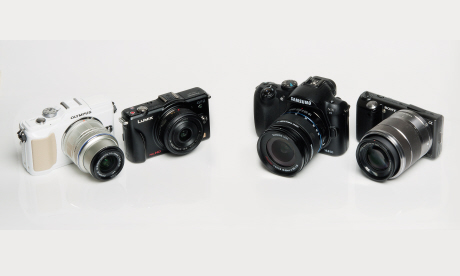
A new breed of camera combining the best bits of compacts and DSLRs has hit the market - but are they any good? Steve Davey puts them to the test
Buying a camera used to be simple: if you were serious about photography you bought a DSLR (digital single-lens reflex) camera; if you weren’t then you went for a compact. Both formats had their advantages, but there was a gulf between them.
But in the last couple of years this gap has been filled by a new breed of cameras combining interchangeable sensors with compact size. Some call them ‘bridge’ or ‘hybrid’ cameras, but we prefer the term ‘compact system camera’ (CSC). But are these new snappers the Buddhist middle way to Nirvana – or just middle of the road?
On the surface, CSCs combine the most attractive elements of compacts and DSLRs, especially for the travel minded. They’re smaller and lighter than DSLRs but still take a range of lenses, giving you a wider choice of focal lengths and wider maximum apertures than your typical compact. Also, zoom lenses tend to have a manual zoom ring, which offers a greater deal of control over the zoom setting.
Because the CSCs don’t have the moveable mirror that allows you to see through the lens (present in DSLRs), they can have smaller bodies. But on the other hand, CSC bodies tend to be bigger than a compact camera, so you get better access to your camera’s manual functions, instead of having to scroll through endless digital menus.
CSCs also tend to have much bigger sensors than a compact, which gives you better quality.
One major drawback of a CSC is the lack of optical viewfinder. You can’t view through the lens as you do with a DSLR; instead you will have to compose your shots via either an electronic viewfinder (sometimes available as an optional extra) or – in many cases – an LCD screen.
You’ll also have to buy into a new technology. Olympus and Panasonic have developed a shared Micro 4/3 format for their CSCs, so you can swap lenses between the two – but with other cameras you’re stuck with that manufacturer’s lenses. Without an adaptor, none of your existing DSLR lenses will fit any of the CSCs. Of course, there’s also the usual DSLR problem of dust getting in when changing lenses.
As the format is new, there are only a few manufacturers making CSCs – and this list doesn’t currently include the two big players in the camera world, Nikon and Canon. The big two are rumoured to be developing CSCs but there’s been no official word yet so the timescale is anyone’s guess.
The format’s recency means that a lot of the projected economies (smaller, cheaper bodies and lenses) haven’t yet materialised. As competition hots up, bargains will emerge as well as – hopefully – the greater degree of standardisation that will allow third-party lens-makers to step into the fray too. But if the format doesn’t take off, you could be left with the camera equivalent of a Betamax video.
So, who should invest? Anyone who wants the quality of a DSLR but finds them too big and bulky for comfort. Certainly they’re ideal for travellers, and for anyone who wants to take more control of their photos without the weight or handling size of a conventional DSLR.
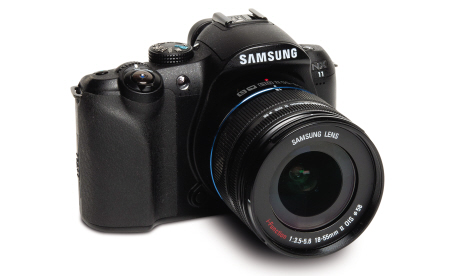 Samsung NX11 with 18-55mm F3.5-5.6 (effective 27-82.5mm)
Samsung NX11 with 18-55mm F3.5-5.6 (effective 27-82.5mm)The Samsung NX11 looks just like a mini DSLR. The handling feels great – even with my big hands – with good access to functions. It feels solid, although heavier than you might expect.
It’s built around a 14.6MP CMOS sensor, capable of shooting in the versatile RAW format. This is APS-C sized – effectively the same as an entry-level DSLR. The camera has a bright, clear electronic viewfinder as well as an LCD screen.
The NX11 comes with an 18-55mm kit lens but a major drawback is that it uses its own NX lens mount. Currently there is a limited range of seven Samsung lenses, ranging between 18mm and 200mm, although you can buy adaptors that will let you use other existing DSLR lenses. It reduces the CSC’s size advantage, but it does open up the possibility of using a NX11 as a solid backup camera to an existing DSLR kit.
The ISO range is 100-3,200. Quality is good at the lower end of the ISO range, but the noise becomes somewhat intrusive when you get towards 3,200.
Other notable features are a pop-up flash, image stabilisation, a 16:9 panoramic format and HD movie mode.
Dimensions: 123mm x 87mm x 49mm
Weight: 353g
ISO rating: 100-3,200
Megapixels: 14.6
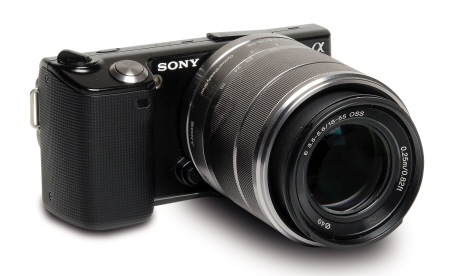 Sony NEX-5 with 18-55mm F3.5-5.6 (effective 27-82.5mm)
Sony NEX-5 with 18-55mm F3.5-5.6 (effective 27-82.5mm)The NEX-5 is a strange-looking beast, like someone has jammed a serious silver lens onto the edge of a compact camera. This means that the handling is somewhat unbalanced when it’s used with the 18-55mm zoom.
The build quality is good, but there is a dearth of buttons and dials, with many of the controls buried in unwieldy menus.
The camera has a 14.2MP CMOS sensor and can shoot RAW. The ISO range is officially 200-12,800, and is usable up to 6,400. The small body (especially when compared to the NX11) does come with some drawbacks though. The biggest is the lack of an electronic viewfinder, but there’s also no built-in flash, just a dinky plug-in unit that could be easily lost.
The Sony has its own proprietary lens mount, so there is currently a limited range of lenses. Just four are listed on the website, ranging between 16mm and 200mm. You can fit Sony DSLR lenses using an adaptor, but this compromises the size – although it does make the NEX-5 the ideal companion to a Sony DSLR system.
Other notable features include a 16:9 panoramic mode, full HD video and image stabilisation.
+ Full 1,080 HD video
+ High ISO performance
– Unbalanced handling
– Proprietary lens format
– No electronic viewfinder
– Small separate flash
Dimensions: 111mm x 59mm x 38mm
Weight: 229g
ISO rating: 200-12,800
Megapixels: 14.2
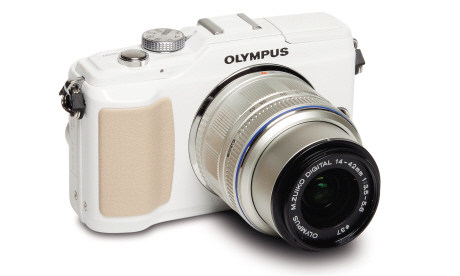 Olympus Pen EPL-2 with 14-42mm F3.5-5.6 (effective 28-84mm)
Olympus Pen EPL-2 with 14-42mm F3.5-5.6 (effective 28-84mm)The Pen EPL-2 uses the same four-thirds sensor that is used in Olympus DSLRs, but also takes lenses with the Micro 4/3 Lens Mount. This is the closest thing to an open standard in CSCs (making it the mount most likely to be used by third-party lens-makers – it’s also used by Panasonic), giving you the widest choice of lenses.
The drawback of the Micro 4/3 mount is that it gives a squarer 4:3 ratio image, out of keeping with the trend towards widescreen. The sensor gives a maximum resolution of 12.3MP and can shoot RAW. The ISO range is 100-6,400, and gives good results across the range.
The balance and handling are good, but some of the important functions are menu-based, which is less convenient.
There’s no built-in viewfinder, but one is available as a bolt-on using the AP-2 accessory socket. There is a built-in flash and also a standard flash hot shoe for more powerful flashguns. Other notable features include availability of a bespoke underwater housing (around £600), HD video and image stabilisation.
Dimensions: 120.5mm x 70mm x 35mm
Weight: 335g
ISO rating: 100-6,400
Megapixels: 12.3
NB As we went to press, the EPL-2 was replaced by the EPL-3; RRP £549.99 with 14-42mm lens.
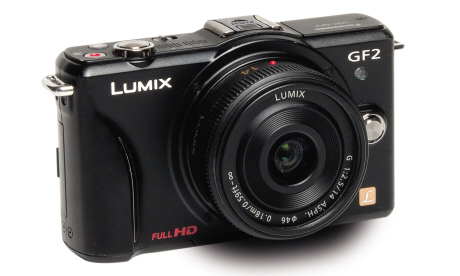 Panasonic DMC-GF2 with 14-42mm F3.5-5.6 (effective 28-84mm)
Panasonic DMC-GF2 with 14-42mm F3.5-5.6 (effective 28-84mm)Like the Olympus, the DMC-GF2 uses the ‘standard’ Micro 4/3 Lens Mount, opening up more possibilities as the range of Olympus and Panasonic lenses is relatively large. Third-party manufacturers moving into the market will (hopefully) help drive prices lower.
The 12.1MP sensor is optimised for the squarer 4:3 image. Crop it to 3:2 format in-camera and the resolution drops to around 10.6MP; 9MP for a 16:9 image. The available lenses range from an 8mm fish-eye and 7-14mm wide zoom through to a 300mm telephoto zoom, which equates to a 600mm lens on a 35mm camera. The 4:3 format has a lens multiplier factor (LMF) of 2x – an advantage and a curse: wide-angle lenses are rendered less wide; telephoto lenses are made more powerful.
The ISO range is 100-6,400. Low ISO quality is good, but noise becomes pronounced above ISO 1,600. Handling and build are good and, although many functions are menu driven, they’re accessed through a touchscreen LCD.
Other notable features include availability of optional optical viewfinder, full HD video and 3D capabilities if you buy a 3D lens.
Which of these cameras is for you depends largely on your own needs. If you want maximum lens choice and compatibility (and the system most likely to be adopted by third-party lens-makers) then opt for the Olympus or the Panasonic. For ISO performance it has to be the Sony. If handling, build quality and an electronic viewfinder are important, go for the Samsung. If you plan to shoot underwater, go for the Olympus . To try 3D, go for the Panasonic.
10 of the best DSLRs for travellers | Inspire me... More
Ever wanted to take better travel photos? Find out how to improve YOUR shots here
10 of the best compacts for travellers | Inspire me... More
How to buy the right camera for you | Advice... More
Check out more articles by professional photographer Steve Davey... More